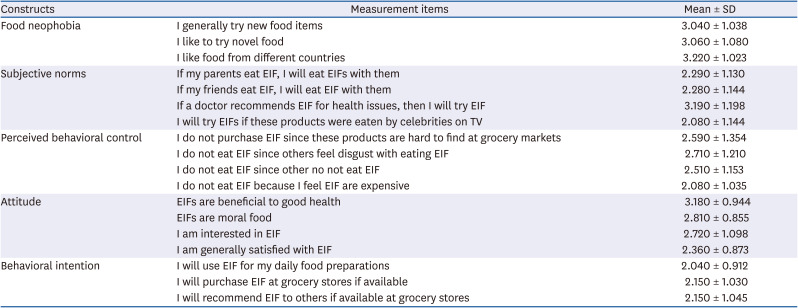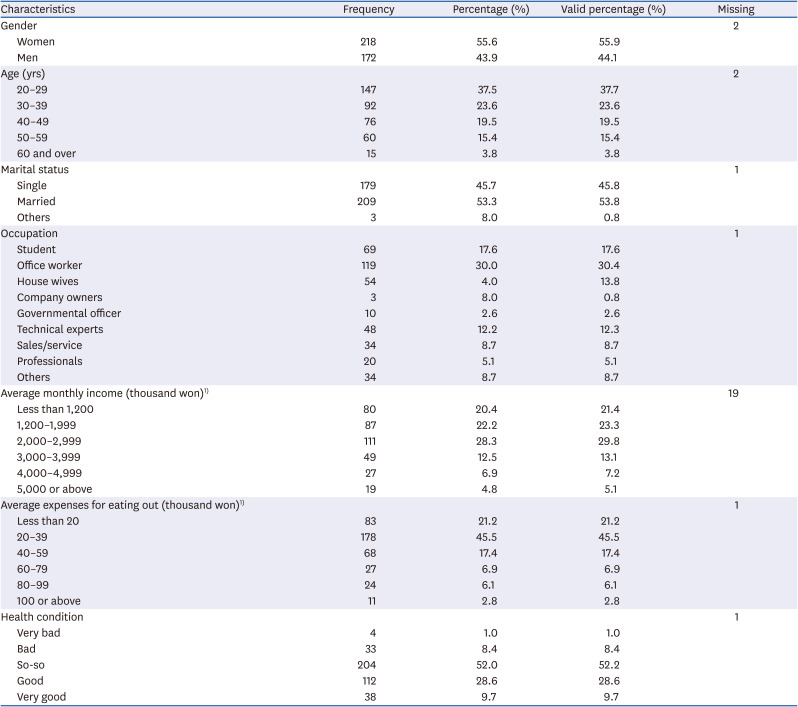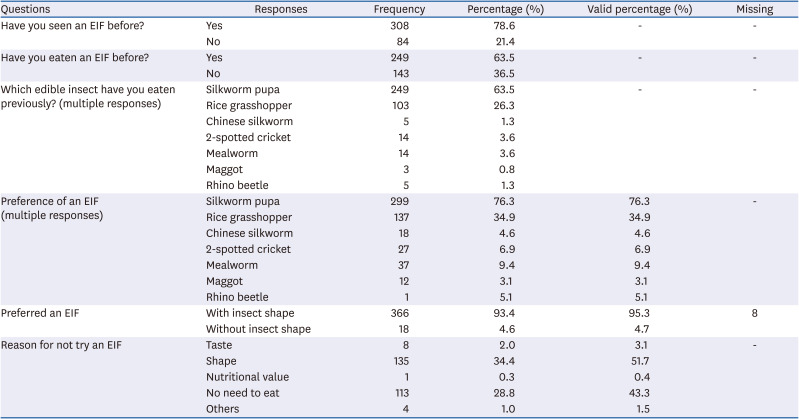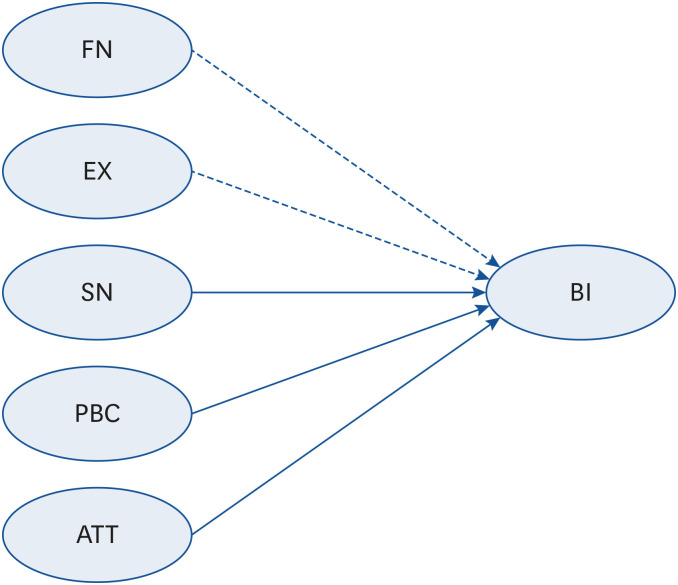1. Verkerk MC, Tramper J, van Trijp JC, Martens DE. Insect cells for human food. Biotechnol Adv. 2007; 25:198–202. PMID:
17197149.


2. Harris M. Good to Eat: Riddles of Food and Culture. New York: Waveland Press;1998.
4. Piha S, Pohjanheimo T, Lähteenmäki-Uutela A, Křečková Z, Otterbring T. The effects of consumer knowledge on the willingness to buy insect food: an exploratory cross-regional study in Northern and Central Europe. Food Qual Prefer. 2018; 70:1–10.

5. Tabassum-Abbasi , Abbasi T, Abbasi SA. Reducing the global environmental impact of livestock production: the mini livestock option. J Clean Prod. 2016; 112:1754–1766.
6. Bukkens S. The nutritional value of edible insects. Ecol Food Nutr. 1997; 36:287–319.

7. Schwartz GE, Weinberger DA, Singer JA. Cardiovascular differentiation of happiness, sadness, anger, and fear following imagery and exercise. Psychosom Med. 1981; 43:343–364. PMID:
7280162.

8. Pliner P, Hobden K. Development of a scale to measure the trait of food neophobia in humans. Appetite. 1992; 19:105–120. PMID:
1489209.


9. Pliner P, Pelchat M, Grabski M. Reduction of neophobia in humans by exposure to novel foods. Appetite. 1993; 20:111–123. PMID:
8507067.


10. Jaeger SR, Rasmussen MA, Prescott J. Relationships between food neophobia and food intake and preferences: findings from a sample of New Zealand adults. Appetite. 2017; 116:410–422. PMID:
28533158.


11. Tuorila H, Lahteenmaki L, Pohjalainen L, Lotti L. Food neophobia among the Finns and related responses to familiar and unfamiliar foods. Food Qual Prefer. 2001; 12:29–37.

12. Tan HS, Fischer AR, Van Trijp HC, Stieger M. Tasty but nasty? Exploring the role of sensory-liking and food appropriateness in the willingness to eat unusual novel foods like insects. Food Qual Prefer. 2016; 48:293–302.

13. Hartmann C, Siegrist M. Becoming an insectivore: results of an experiment. Food Qual Prefer. 2016; 51:118–122.

14. Choe JY, Cho MS. Food neophobia and willingness to try non-traditional food for Koreans. Food Qual Prefer. 2011; 22:671–677.
15. Verbeke W. Profiling consumers who are ready to adopt insects as a meat substitute in a Western society. Food Qual Prefer. 2015; 39:147–155.

16. Wu K, Raab C, Chang W, Krishen A. Understanding Chinese tourists' food consumption in the United States. J Bus Res. 2016; 69:4706–4713.

17. Chen M. Consumer attitudes and purchase intentions in relation to organic foods in Taiwan: moderating effects of food-related personality traits. Food Qual Prefer. 2007; 18:1008–1021.

18. Meiselman HL, King SC, Gillette M. The demographics of neophobia in a large commercial US sample. Food Qual Prefer. 2010; 21:893–897.

19. Pliner P, Pelchat ML. Neophobia in humans and the special status of foods of animal origin. Appetite. 1991; 16:205–218. PMID:
1883248.


20. Hursti UkK , Sjödén P. Food and general neophobia and their relationship with self-reported food choice: familial resemblance in Swedish families with children of ages 7–17 years. Appetite. 1997; 29:89–103. PMID:
9268428.


21. Nicklaus S. The role of food experiences during early childhood in food pleasure learning. Appetite. 2016; 104:3–9. PMID:
26298009.


22. Schwartz C, Scholtens P, Lalanne A, Weenen H, Nicklaus S. Development of healthy eating habits early in life. Review of recent evidence and selected guidelines. Appetite. 2011; 157:796–807.

23. Nicklaus S, Demonteil L, Tournier C. Modifying the texture of foods for infants and young children. In : Chen J, Rosenthal A, editors. Modifying Food Texture, Volume 2: Sensory Analysis, Consumer Requirements and Preferences. London: Woodhead;2015. p. 187–222.
24. Bateson P, Barker D, Clutton-Brock T, Deb D, D'Udine B, Foley RA, et al. Developmental plasticity and human health. Nature. 2004; 430:419–421. PMID:
15269759.

25. Dovey TM, Staples PA, Gibson EL, Halford JC. Food neophobia and ‘picky/fussy’ eating in children: a review. Appetite. 2007; 50:181–193. PMID:
17997196.


26. Kallas Z, Vitale M, Gil JM. Health innovation in patty products. The role of food neophobia in consumers' non-hypothetical willingness to pay, purchase intention and hedonic evaluation. Nutrients. 2019; 11:E444. PMID:
30791660.

27. Korsmeyer C, Sutton D. The sensory experience of food. Food Cult Soc. 2011; 14:461–475.

28. Dacremont C, Sester C. Context in food behavior and product experience – a review. Curr Opin Food Sci. 2019; 27:115–122.

29. Rotter JB. Some problems and misconceptions related to the construct of internal versus external control of reinforcement. J Consult Clin Psychol. 1975; 43:56–67.

30. Norman P, Brain K. An application of an extended health belief model to the prediction of breast self-examination among women with a family history of breast cancer. Br J Health Psychol. 2005; 10:1–16. PMID:
15826330.


31. Russell CA, Buhrau D. The role of television viewing and direct experience in predicting adolescents' beliefs about the health risks of fast-food consumption. Appetite. 2015; 92:200–206. PMID:
26009205.



32. Garber LL Jr, Hyatt EM, Starr RG Jr. Measuring consumer response to food products. Food Qual Prefer. 2003; 14:3–15.

33. Fallon AE, Rozin P. The psychological bases of food rejections by humans. Ecol Food Nutr. 1983; 13:15–26.

34. Gere A, Székely G, Kovács S, Kókai Z, Sipos L. Readiness to adopt insects in Hungary: a case study. Food Qual Prefer. 2017; 59:81–86.

35. Ajzen I, Fishbein M. Understanding Attitudes and Predicting Social Behaviour. Englewood Cliffs: Prentice-Hall;1980.
36. Ajzen I. The theory of planned behavior. Organ Behav Hum Decis Process. 1991; 50:179–211.

37. Ajzen I, Madden TJ. Prediction of goal directed behavior: attitudes, intentions, and perceived behavioral control. J Exp Soc Psychol. 1986; 22:453–474.
38. Batra R, Ahtola OT. Measuring the hedonic and utilitarian sources of consumer attitudes. Mark Lett. 1991; 2:159–170.

39. Fazio RH, Chen JM, McDonel EC, Sherman SJ. Attitude accessibility, attitude-behavior consistency and the strength of the object-evaluation association. J Exp Soc Psychol. 1982; 18:339–357.

40. Brunsø K, Scholderer J, Grunert KG. Closing the gap between values and behavior - a means-end theory of lifestyle. J Bus Res. 2004; 57:665–670.
41. Shin YH, Hancer M. The role of attitude, subjective norm, perceived behavioral control, and moral norm in the intention to purchase local food products. J Foodserv Bus Res. 2016; 19:338–351.

42. Yazdanpanah M, Forouzani M. Application of the theory of planned behaviour to predict Iranian students' intention to purchase organic food. J Clean Prod. 2015; 107:342–352.

43. Mirkarimi K, Eri M, Ghanbari MR, Kabir MJ, Raeisi M, Ozouni-Davaji RB, Aryaie M, Charkazi A. Modifying attitude and intention toward regular physical activity using protection motivation theory: a randomized controlled trial. East Mediterr Health J. 2017; 23:543–550. PMID:
29105045.


44. Qamar Z, McIntosh A, Hicks K. Improved perceived behavioral control in choosing fruits and vegetables as a result of the online nutrition program for South Asians. J Acad Nutr Diet. 2017; 117:A58.

45. Chen M. Modeling an extended theory of planned behavior model to predict intention to take precautions to avoid consuming food with additives. Food Qual Prefer. 2017; 58:24–33.

46. Arvola A, Vassallo M, Dean M, Lampila P, Saba A, Lähteenmäki L, Shepherd R. Predicting intentions to purchase organic food: the role of affective and moral attitudes in the theory of planned behaviour. Appetite. 2008; 50:443–454. PMID:
18036702.


47. Menozzi G, Sogari C, Mora D. Explaining vegetable consumption among young adults: an application of the theory of planned behaviour. Nutrients. 2015; 7:7633–7650. PMID:
26378570.


48. McNeil K, Kelly F, McNeil J. Testing Research Hypotheses Using Multiple Linear Regression. Carbondale: South Illinois University Press;1975.
49. Nusair K, Hua N. Comparative assessment of structural equation modeling and multiple regression research methodologies: E-commerce context. Tour Manage. 2010; 31:314–324.

50. Shaw D, Shiu E. Ethics in consumer choice: a multivariate modelling approach. Eur J Mark. 2003; 37:1485–1498.












 PDF
PDF Citation
Citation Print
Print






 XML Download
XML Download